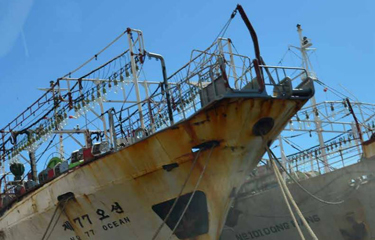New research has revealed a surge in operations by Chinese fleets in what’s described as a previously unknown squid fishery on the high seas of the Northwest Indian Ocean.
A document produced by Norway-based nonprofit Trygg Mat Tracking (TMT), with data and analytical support from Global Fishing Watch, has revealed a dramatic increase in the number of vessels in the area, which borders the exclusive economic zones of Oman and Yemen.
The research paper published by TMT, which includes detailed analysis of satellite data as well as drone footage, concludes that “an increasing number of the fishing vessels operating in this area are multipurpose and it is possible that other species, such as tuna and small pelagic fish, are also targeted.”
At-sea documentation of vessels and fishing operations conducted in cooperation with Greenpeace International shows a very erratic use of onboard identification systems by the boats, with the fishing vessels in many cases switching off their AIS signals on arrival in the fishing zone, TMT reported.
The research also reveals the widespread use of nets rather than jiggers in the fishery. Nets are often used as a way to reduce manpower requirements on vessels, but their use also increases the amount of bycatch caught, according to TMT. TMT also said drone footage showing the widespread presence of small squid in the vessels’ catch could impact future stocks of tuna in the region, given the importance of small squid as a primary food source for tuna.
The high-seas fishing grounds in question fall outside the remit of any regional fisheries management organization (RFMO) with a mandate to manage species other than tuna. Thus, regulation of the Northwest Indian Ocean squid fishery is entirely reliant on participating flag-states – similar to the situation in the Southwest Atlantic fishery, which has been subject to increasing fishing pressure from Chinese fleets in recent years.
The Northwest Indian Ocean fishery generally starts around October each year, peaks in terms of number of vessels present in November to January, and then decreases through to late May. The Trygg Mat Tracking report suggests a more than sixfold increase in the number of vessels in the fishery between 2016 and 2019. This is consistent with increases in China’s distant-water activity as highlighted in a recent report by Chinese market research agency Qianzhan, which shows China’s distant-water catch more than doubled in value over the past decade.
Evidence from AIS analysis indicates that the vast majority of vessels (if not all) that are targeting squid in the Northwest Indian Ocean are Chinese-flagged, while reefers tracked by the research are also all flagged to China or Panama. Vessels from two Chinese ports – Fuzhou and Zhoushan – appeared to be particularly active in the fishery, TMT said. Zhoushan is home to approximately two-thirds of China’s distant-water fleet and claims to be the world’s leading destination for global squid catches, and Fuzhou is in the process of constructing a CNY 2.3 billion (USD 345 million, EUR 299 million) distant-water fishery base with financial support from the provincial government.
The value of China’s distant-water catch hit CNY 26.2 billion (USD 4.2 billion, EUR 3.6 billion) in 2018, a significant jump over the CNY 13.5 billion (USD 2.1 billion, EUR 1.8 billion) it accounted for in 2012. But an “adjustment in the content” of the catch meant the value of China’s distant-water catch fell 1.8 percent year-on-year in 2020 to CNY 23.9 billion (USD 3.8 billion, EUR 3.3 billion), according to Qianzhan, reflecting a shift in focus by China’s expanding distant-water fleet onto squid.
Chinese Agriculture Ministry data shows that squid and tuna – with 520,300 metric tons (MT) and 327,400 MT caught in 2020, respectively – now constitute the top two species in China’s overall distant-water catch. Squid represents 22.5 percent of the total catch and tuna represents 14 percent of the 2020 catch total, the ministry said.
In November 2021, China’s Agriculture Ministry, which licenses the country’s distant-water fleet, issued a circular titled “Regarding Improved Regulation of Squid-Fishing Work,” which pledged a capping of the fleet and promised tighter administrative approval and performance evaluation systems for the fleet. It also pledged “active conservation of high-seas squid resources” and better supervision of landings of squid in Chinese ports. That could be why the TMT report described the fact that all Northwest Indian Ocean vessels are from one country as “represent[ing] a challenge but potentially also an opportunity for strengthening the management and regulation of this fishery.”
But the circular also said the ministry “will increase the exploration and catching of new resources … in new fishing grounds.” The TMT research report makes various references to the increased presence of Chinese government-licensed and funded fishery exploration or research vessels in the Northwest Indian Ocean.
Photo courtesy of Trygg Mat Tracking







